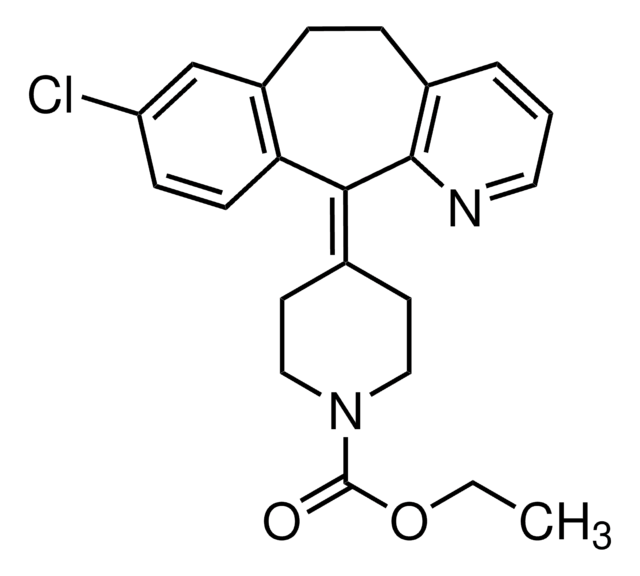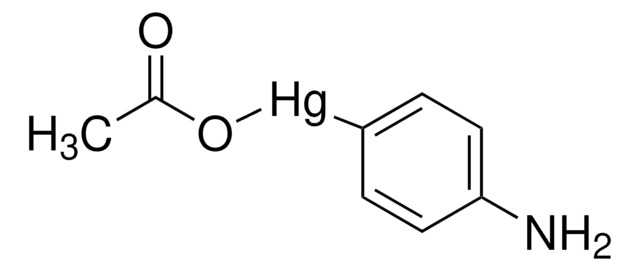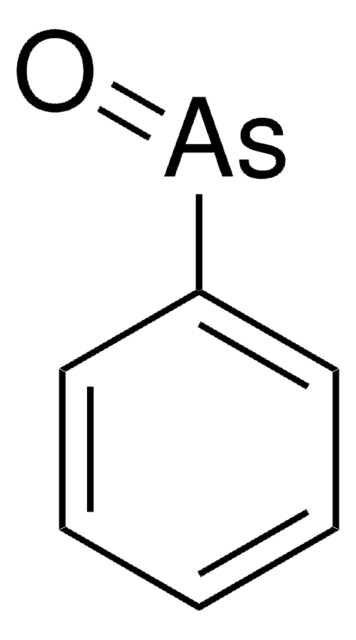N7009
2-Nitro-5-thiocyanatobenzoic acid
≥98% (HPLC)
Sinonimo/i:
2-Nitro-5-thiocyanobenzoic acid, NTCB
About This Item
Prodotti consigliati
Nome del prodotto
2-Nitro-5-thiocyanatobenzoic acid, powder
Saggio
≥98% (HPLC)
Livello qualitativo
Stato
powder
Colore
yellow
Punto di fusione
156-157 °C (lit.)
Temperatura di conservazione
2-8°C
Stringa SMILE
OC(=O)c1cc(SC#N)ccc1[N+]([O-])=O
InChI
1S/C8H4N2O4S/c9-4-15-5-1-2-7(10(13)14)6(3-5)8(11)12/h1-3H,(H,11,12)
NQUNIMFHIWQQGJ-UHFFFAOYSA-N
Cerchi prodotti simili? Visita Guida al confronto tra prodotti
Applicazioni
- Site-Specific Conversion of Cysteine in a Protein to Dehydroalanine Using 2-Nitro-5-thiocyanatobenzoic Acid: This research demonstrates the use of 2-Nitro-5-thiocyanatobenzoic acid in protein engineering to modify cysteine residues, which is critical for developing therapeutic proteins and understanding protein structure-function relationships (Qiao et al., 2021).
- Scrapie prion protein structural constraints obtained by limited proteolysis and mass spectrometry: Highlights the utility of 2-Nitro-5-thiocyanatobenzoic acid in the study of prion proteins, providing insights into protein misfolding diseases which can lead to novel therapeutic approaches (Sajnani et al., 2008).
- Localization of a substrate binding domain of the human reduced folate carrier to transmembrane domain 11 by radioaffinity labeling and cysteine-substituted accessibility methods: Utilizes 2-Nitro-5-thiocyanatobenzoic acid in biochemical assays to understand transporter proteins, essential for drug delivery and targeting (Hou et al., 2005).
- A novel procedure for the preparation of biologically active recombinant peptides using a cyanylation reaction: Describes a method using 2-Nitro-5-thiocyanatobenzoic acid for peptide synthesis, beneficial for the development of peptide-based pharmaceuticals (Koyama et al., 1994).
Azioni biochim/fisiol
Confezionamento
Avvertenze
Warning
Indicazioni di pericolo
Consigli di prudenza
Classi di pericolo
Eye Irrit. 2 - Skin Irrit. 2 - STOT SE 3
Organi bersaglio
Respiratory system
Codice della classe di stoccaggio
11 - Combustible Solids
Classe di pericolosità dell'acqua (WGK)
WGK 3
Punto d’infiammabilità (°F)
Not applicable
Punto d’infiammabilità (°C)
Not applicable
Dispositivi di protezione individuale
dust mask type N95 (US), Eyeshields, Gloves
Scegli una delle versioni più recenti:
Possiedi già questo prodotto?
I documenti relativi ai prodotti acquistati recentemente sono disponibili nell’Archivio dei documenti.
I clienti hanno visto anche
Il team dei nostri ricercatori vanta grande esperienza in tutte le aree della ricerca quali Life Science, scienza dei materiali, sintesi chimica, cromatografia, discipline analitiche, ecc..
Contatta l'Assistenza Tecnica.










